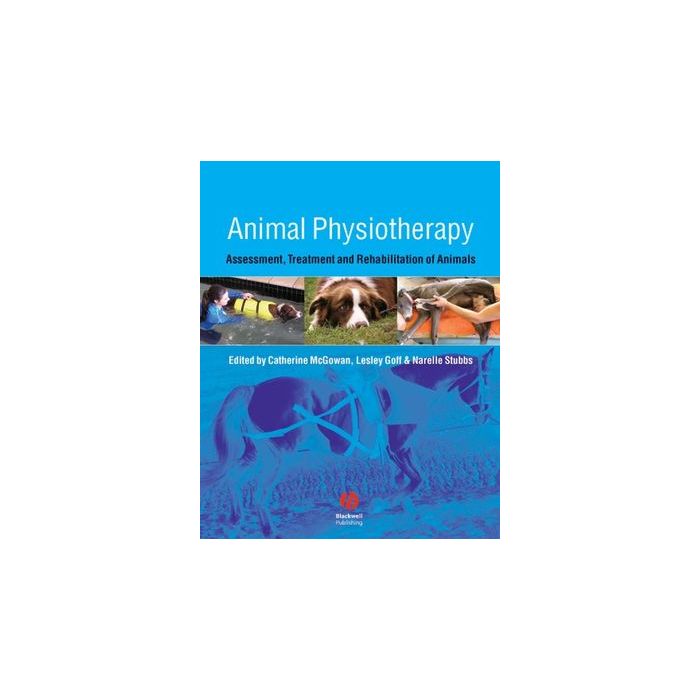Animal Physiotherapy: Assessment, Treatment and Rehabilitation of Animals [McGowan - Wiley - Blackwell]

- ISBN/EAN
- 9781405131957
- Editore
- Wiley - Blackwell
- Formato
- Brossura
- Anno
- 2007
- Pagine
- 272
Disponibile
75,00 €
Animal Physiotherapy is an essential reference guide for physiotherapists looking to apply the proven benefits of physiotherapy to the treatment of companion and performance animals. Animal Physiotherapy is a growing profession of physiotherapists who have broadened their expertise from the well-established human sphere to animals. The positive perception of physiotherapy in the human sphere, together with an increased awareness of options and expertise available for animals has resulted in a strong demand for physiotherapy for animals.
For the physiotherapist this book provides essential applied background information on animal behaviour, nutrition, biomechanics and exercise physiology. For veterinarians and others who work with animals, the book reviews the scientific principles behind the practice of physiotherapy, and what it can achieve.
Includes reviews of different physiotherapy techniques, drawing on both human and animal literature;
Discusses approaches in small animal medicine as well as for elite equine athletes;
Includes applied evidence-based clinical reasoning model, providing case examples
Maggiori Informazioni
| Autore | McGowan Catherine; Goff Lesley; Stubbs Narelle |
|---|---|
| Editore | Wiley - Blackwell |
| Anno | 2007 |
| Tipologia | Libro |
| Lingua | Inglese |
| Indice | Chapter 1 Introduction 1 Catherine McGowan Chapter 2 Applied animal behaviour: assessment, pain and aggression 3 Daniel Mills, Suzanne Millman and Emily Levine 2.1 Introduction 3 2.1.1 Assessment of animal behaviour 4 2.2 Pain 7 2.3 Aggression 11 2.4 Conclusion 12 References 12 Further reading 13 Chapter 3 Applied animal nutrition 14 Linda M. Fleeman and Elizabeth Owens 3.1 Small animal nutrition 14 3.2 Applied equine nutrition 21 References 29 Chapter 4 Applied animal biomechanics 32 Lesley Goff and Narelle Stubbs 4.1 Introduction 32 4.2 Joint biomechanics 32 4.3 Biomechanics of the vertebral joints 34 4.4 Canine vertebral column 34 4.5 Equine vertebral column 37 4.6 Canine peripheral joints 39 4.7 Equine peripheral joints 41 4.8 Mechanics of locomotion: the dog 44 4.9 Mechanics of locomotion: the horse 45 4.10 Considerations in sport-specific pathology 49 4.11 Biomechanics of the equine foot 52 4.12 Conclusion 53 References 53 Further reading 55 Chapter 5 Comparative exercise physiology 56 Catherine McGowan and Brian Hampson 5.1 Introduction 56 5.2 Principles of exercise physiology 56 5.3 The pathway of oxygen 58 5.4 Cardiorespiratory function during exercise 59 5.5 The effect of training 60 5.6 Detraining 61 5.7 Applied exercise physiology 61 5.8 High altitude training 62 5.9 Maximal performance and factors limiting maximal performance in the horse 62 5.10 Training the sled dog (Husky) 65 5.11 Programme phases 67 5.12 Aims of the programme design 69 5.13 Training the racing Greyhound 69 5.14 Aims of the programme design 70 References 71 Chapter 6 Equine and canine lameness 73 Nicholas Malikides, Thomas McGowan and Matthew Pead 6.1 Equine lameness 73 6.2 Canine lameness 91 References 100 Further reading 101 Chapter 7 Neurological and muscular conditions 102 Philip A. Moses and Catherine McGowan 7.1 Introduction 102 7.2 Neuroanatomy 102 7.3 Neurological examination 104 7.4 Posture, gait and reflexes in small animals 107 7.5 Posture, gait and reflexes in horses 111 7.6 Diagnostic techniques 113 7.7 Neurological disease in small animals 114 7.8 Equine neurological diseases 124 7.9 Intrinsic muscle disease 131 References 134 Chapter 8 Physiotherapy assessment for animals 136 Lesley Goff and Tracy Crook 8.1 Introduction 136 8.2 Clinical reasoning 137 8.3 Physical assessment 141 8.4 Special considerations in canine physiotherapy assessment 146 8.5 Assessment and palpation of canine extremities 148 8.6 Special considerations in equine physiotherapy assessment 151 8.7 Equine palpation 152 8.8 Conclusion 162 References 162 Chapter 9 Manual therapy 164 Lesley Goff and Gwendolen Jull 9.1 Introduction 164 9.2 Technical aspects of manual therapy 164 9.3 Manual therapy in practice 167 9.4 Dogs 169 9.5 Horses 172 9.6 Conclusion 175 References 175 Chapter 10 Principles of electrotherapy in veterinary physiotherapy 177 G. David Baxter and Suzanne M. McDonough 10.1 Overview 177 10.2 Electrical stimulation of tissue 177 10.3 Electrical stimulation for pain relief 179 10.4 Electrostimulation of muscles 180 10.5 Laser therapy 182 10.6 Ultrasound therapy 184 10.7 Evidence-based practice 186 10.8 Summary and conclusions 186 References 186 Chapter 11 Hydrotherapy 187 Michelle Monk 11.1 Introduction 187 11.2 Physical properties of water 187 11.3 Physiological responses to exercising in water 189 11.4 Evidence for effectiveness of hydrotherapy 191 11.5 Benefits of hydrotherapy for animals 192 11.6 Assessment of the small animal patient for hydrotherapy 192 11.7 Types of hydrotherapy for animals 193 References 197 Chapter 12 Acupuncture and trigger points 199 Tina Souvlis 12.1 Introduction 199 12.2 Traditional acupuncture 199 12.3 Acupuncture analgesia 200 12.4 Clinical effectiveness of acupuncture 201 12.5 Use of acupuncture in animals 202 12.6 Trigger points 202 References 204 Chapter 13 Canine treatment and rehabilitation 207 Laurie Edge-Hughes and Helen Nicholson 13.1 Introduction 207 13.2 Canine orthopaedic rehabilitation 207 13.3 Additional concepts regarding soft tissue injury 211 13.4 Osteoarthritis 213 13.5 Post-operative rehabilitation 215 13.6 Fracture healing 218 13.7 Hip dysplasia 221 13.8 Conditioning canine athletes 222 13.9 Respiratory physiotherapy 224 13.10 Cardiac rehabilitation 227 13.11 Neurological physiotherapy 229 References 234 Chapter 14 Equine treatment and rehabilitation 238 Lesley Goff and Narelle Stubbs 14.1 Introduction 238 14.2 Exercise-based rehabilitation 239 14.3 Stretching for injury prevention and rehabilitation 244 14.4 Assessment of the horse and rider unit 248 References 250 Index 252 |
Questo libro è anche in:
